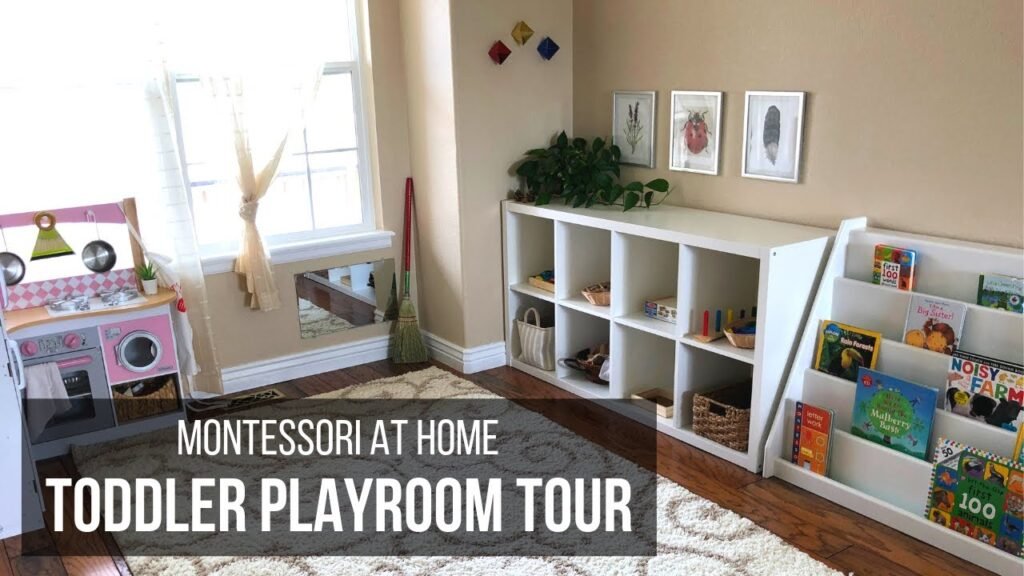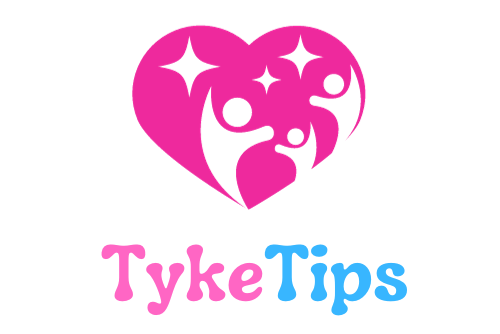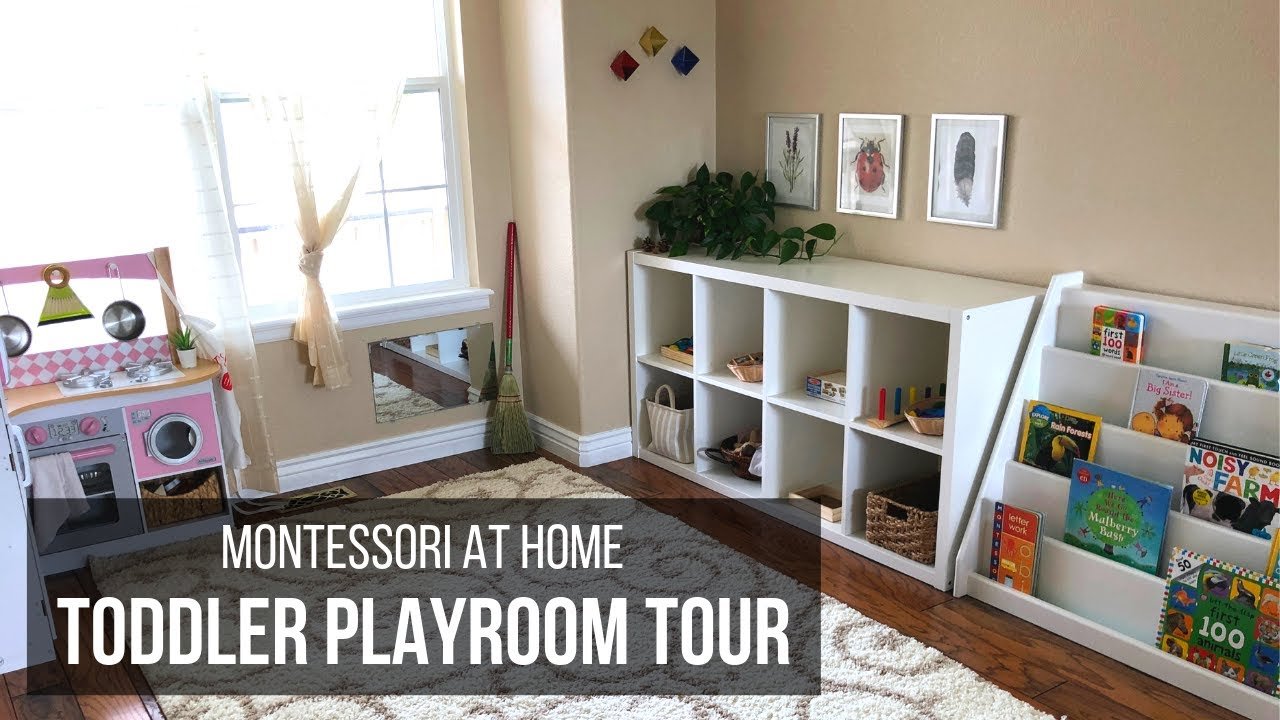Ashley, a mom of two girls, recently shared an updated tour of her daughter Kylie’s Montessori playroom. Now that Kylie is two years old, the video provides easy and engaging ideas for Montessori activities for toddlers. The video includes recommendations for reading, audio, and video gear used, along with music by MusicToday80. If you’re interested in Montessori principles at home, check out Hapa Family’s Instagram and reach out for any business inquiries.
Ashley’s Montessori playroom for her two-year-old daughter is filled with activities to meet her developmental needs. From fine motor skills to open-ended play, the shelves in the playroom offer a variety of engaging options. Ashley also emphasizes the importance of choosing literature based on reality for her daughter’s bookshelf, and engaging in meaningful conversations about the books they read together. With practical tips for implementing Montessori principles at home, Ashley hopes to inspire other parents to create a stimulating and educational play area for their toddlers.

Overview of Kylie’s Montessori Playroom at 2 Years Old
Kylie’s Montessori playroom at 2 years old is a vibrant and engaging space carefully designed to foster her development. The layout of the playroom is meticulously organized to cater to Kylie’s growing interests and abilities. Each area of the playroom has been curated with age-appropriate activities to encourage her curiosity and exploration.
Description of playroom layout
The playroom is divided into distinct areas, including a play kitchen, art space, and shelves with various learning materials. These zones are strategically placed within the room to promote independence and stimulate Kylie’s creativity. The layout allows her to freely navigate the space and choose activities based on her preferences.
Introduction to key areas in the playroom
-
Play Kitchen: A designated corner for pretend play, where Kylie can engage in practical life activities. It includes a variety of play food, utensils, and cooking accessories to enhance her imaginative play.
-
Art Space: An area dedicated to artistic expression, equipped with art supplies and materials for Kylie to explore her creativity. This space encourages sensory exploration and fine motor skill development through painting, drawing, and crafting.
-
Shelves with Learning Materials: The shelves in the playroom are meticulously organized with age-appropriate activities that cater to Kylie’s developmental needs. These activities focus on fine motor skills, music, puzzles, sorting, movement, and open-ended play to provide a holistic learning experience.
Explanation of age-appropriate activities
The playroom is equipped with activities designed to support Kylie’s cognitive, physical, and emotional development. From engaging in hands-on activities to fostering language skills through interactive play, each component of the playroom has been carefully curated to align with Montessori principles. These activities aim to promote independence, creativity, and a love for learning in Kylie’s early years.
Montessori Activities for Toddlers
Engaging toddlers in Montessori activities at a young age is crucial for their overall development. These activities are designed to enhance cognitive skills, boost creativity, and foster a sense of independence in toddlers. By incorporating hands-on learning experiences, toddlers learn to explore, discover, and problem-solve in a supportive environment.
Importance of Montessori activities for toddlers
Montessori activities play a vital role in promoting self-discovery and independent learning in toddlers. By engaging in age-appropriate tasks, toddlers develop concentration, fine motor skills, and a sense of order. These activities also cultivate a love for learning and instill a sense of accomplishment in young children.
Benefits of hands-on learning experiences
Hands-on learning experiences allow toddlers to interact and engage with their environment actively. Through sensory exploration, practical life activities, and problem-solving tasks, toddlers develop critical thinking skills, creativity, and perseverance. These experiences help build self-confidence and independence in toddlers as they navigate through various challenges.
Examples of engaging activities for toddlers
-
Practical Life Activities: Activities such as pouring, spooning, and dressing help toddlers develop coordination and independence.
-
Sensorial Activities: Sensory bins, texture boards, and sound exploration activities stimulate toddlers’ senses and promote cognitive development.
-
Math and Language Activities: Counting games, matching activities, and language cards introduce toddlers to essential math and language concepts in a fun and interactive way.
Recommendations for Reading Materials
Introducing toddlers to age-appropriate books is essential for early literacy development and language acquisition. Reading with toddlers not only enhances their vocabulary but also nurtures their imagination and cognitive abilities. Selecting engaging books that cater to toddlers’ interests and developmental stages is key to fostering a love for reading.
Book suggestions for toddlers
Curating a collection of diverse books with engaging illustrations, interactive elements, and relatable characters is ideal for toddlers. Picture books, board books, and interactive storybooks that encourage participation and storytelling are highly recommended. Books that explore diverse themes, emotions, and experiences can help broaden toddlers’ understanding of the world around them.
Discussion on the importance of reading with toddlers
Reading with toddlers promotes bonding, language development, and a love for storytelling. It creates a nurturing environment for language acquisition, cognitive growth, and emotional expression. Regular reading sessions with toddlers not only enhance their literacy skills but also ignite their curiosity and imagination.
Tips for selecting age-appropriate books
When choosing books for toddlers, consider their interests, attention span, and developmental stage. Opt for books with bright colors, simple language, and engaging illustrations to captivate their attention. Incorporate interactive elements, such as lift-the-flap features, touch-and-feel textures, and sound effects, to make reading sessions interactive and exciting.
Audio and Video Gear Used
Creating engaging and educational content for toddlers requires the use of suitable audio and video gear. High-quality recording equipment ensures that the content is visually appealing, well-produced, and engaging for young audiences. Selecting the right gear for vlogs, tutorials, and educational videos can significantly enhance the viewing experience for children.
Explanation of gear used for audio and video recording
To produce engaging content for toddlers, creators typically use cameras, microphones, lighting equipment, and editing software. These tools help capture high-quality visuals, clear audio, and seamless editing for videos. Investing in reliable gear enables creators to deliver professional and captivating content that resonates with young viewers.
Tips for creating engaging content for toddlers
When creating content for toddlers, consider their interests, attention span, and learning preferences. Incorporate interactive elements, engaging visuals, and lively storytelling to capture and maintain their interest. Utilize age-appropriate language, music, and visuals to create an immersive and educational experience for young audiences.
Guide on selecting quality gear for vlogs
When choosing audio and video gear for vlogs and educational content, prioritize equipment that offers superior audio and video quality. Invest in a high-resolution camera, a quality microphone, and adequate lighting to ensure clear visuals and crisp sound. Evaluate editing software options that provide user-friendly features to enhance the production value of videos.
Hapa Family Instagram and Business Inquiries
Connect with Hapa Family on Instagram for updates, behind-the-scenes content, and engaging posts related to parenting, Montessori activities, and family adventures. Stay informed about upcoming videos, collaborations, and exclusive content by following Hapa Family on Instagram at @hapafamilyvlog.
Information on following Hapa Family on Instagram
Get a glimpse into the daily lives of the Hapa Family by following their Instagram account. Explore photos, stories, and interactive posts that showcase their parenting journey, Montessori-inspired activities, and family bonding moments. Stay connected with Hapa Family through Instagram for the latest updates and exclusive content.
Contact details for business inquiries
For business inquiries, collaborations, or partnership opportunities, reach out to Hapa Family via email at hapafamilyvlog@gmail.com. Connect with the team to discuss potential collaborations, sponsored content, or promotional activities that align with Hapa Family’s values and vision. Explore partnership opportunities with Hapa Family to create engaging and impactful content for families and children.
Collaboration opportunities with Hapa Family
Hapa Family welcomes collaboration opportunities with brands, organizations, and creators who share a passion for family-friendly content, educational resources, and positive parenting. Collaborate with Hapa Family on sponsored videos, product reviews, brand promotions, or creative projects that resonate with their audience. Join forces with Hapa Family to reach a diverse and engaged community of parents and caregivers.
Creator’s Music and Video Content
Experience the vibrant and engaging music featured in Hapa Family’s videos, credited to MusicToday80. Discover the upbeat and cheerful music that accompanies Hapa Family’s content, creating a lively and fun atmosphere for young viewers. Explore the music credits and licensing details provided in the video description to learn more about the music used in Hapa Family’s videos.
Music credits used in the video
The music featured in Hapa Family’s videos is sourced from MusicToday80, known for producing happy and engaging tunes that enhance the viewing experience. The upbeat and upbeat music sets the tone for Hapa Family’s content, creating a cheerful and lively atmosphere that captures the essence of family bonding and joyful moments. Check out the music credits and licensing information in the video description for details on the tracks used in Hapa Family’s videos.
Details on non-sponsored video content
Hapa Family’s videos are created with authenticity, creativity, and a genuine passion for family-friendly content. The video content reflects the daily adventures, parenting tips, and educational activities shared by the Hapa Family. Enjoy non-sponsored videos that offer a glimpse into the real-life experiences of raising children, creating engaging play environments, and promoting positive parenting practices.
Disclaimer on affiliate links provided in the description
Some links included in the video description may be affiliate links, which means that Hapa Family may receive a small commission from purchases made through those links. These affiliate links support the channel and enable Hapa Family to continue creating free and valuable content for viewers. Rest assured that using affiliate links does not incur any additional charges for the viewers, and it helps sustain the production of high-quality videos for the audience.
Parenting Tips from Ashley
Gain valuable insights and parenting tips from Ashley, a dedicated mom of two girls, including a toddler and a baby. Follow Ashley’s parenting journey, recommendations, and personal experiences as she navigates the joys and challenges of raising children in a Montessori-inspired environment. Discover practical advice, creative ideas, and encouragement for interactive and educational activities with children.
Overview of Ashley’s parenting journey
Ashley shares her experiences, challenges, and triumphs as a mother raising two young daughters. Follow her journey as she embraces Montessori principles, creates engaging play spaces, and fosters a nurturing environment for her children. Learn from Ashley’s personal anecdotes, tips, and reflections on parenting, child development, and family dynamics.
Recommendations from Ashley’s personal experience
Drawing from her personal experiences, Ashley offers insights and recommendations on parenting, creating engaging learning environments, and fostering positive relationships with children. Discover effective strategies, creative activities, and practical tips that Ashley has found beneficial in her own parenting journey. Benefit from Ashley’s firsthand knowledge and expertise in raising young children in a Montessori-inspired setting.
Encouragement for interactive and educational activities with children
Ashley encourages parents to engage in interactive, educational, and meaningful activities with their children to promote bonding, learning, and personal growth. Through hands-on experiences, open-ended play, and genuine interactions, parents can create lasting memories and meaningful connections with their children. Embrace the joys of parenting, explore new activities, and nurture a love for lifelong learning with your little ones.
Incorporating Montessori Principles at Home
Discover practical tips and strategies for implementing Montessori principles in your home environment. Transform your living space into a Montessori-friendly setting that promotes independence, creativity, and self-directed learning for children. Embrace the core values of Montessori education to create a nurturing, engaging, and enriched environment for your family.
Discussion on practical tips for Montessori at home
Explore simple and effective ways to incorporate Montessori principles into your daily routines and home environment. From setting up child-friendly spaces to organizing learning materials, implementing Montessori practices at home can enhance your child’s cognitive, emotional, and social development. Discover practical tips, resources, and ideas for creating a Montessori-inspired atmosphere in your home.
Benefits of implementing Montessori principles in daily routines
By integrating Montessori principles into your daily routines, you can enhance your child’s independence, confidence, and love for learning. Establishing a Montessori-inspired environment fosters self-regulation, exploration, and problem-solving skills in children. Embrace the philosophy of “follow the child” and provide opportunities for hands-on learning, independence, and creativity in your home.
Steps to create a Montessori-friendly environment at home
Transforming your home into a Montessori-friendly environment requires thoughtful planning, organization, and creativity. Designate child-friendly areas for play, exploration, and independent activities. Invest in age-appropriate learning materials, furniture, and tools that support your child’s development. Create a harmonious balance between structure and freedom to encourage self-discovery, creativity, and personal growth in your child.
Additional Playroom Ideas
Explore creative and engaging playroom ideas to inspire and enrich your child’s play experiences. From gross motor toys to art materials, discover a variety of activities that promote physical, cognitive, and emotional development. Rotate activities, introduce new toys, and create a dynamic play environment that keeps your child engaged, curious, and eager to learn.
Suggestions for gross motor toys in the play area
Incorporate gross motor toys such as climbing structures, balance beams, and tunnels to encourage physical activity and coordination. Create a safe and stimulating environment where children can explore, move, and develop their motor skills. Engage in activities that promote balance, strength, and spatial awareness while providing opportunities for active play and exercise.
Art materials and activities for creative exploration
Encourage creative exploration and self-expression through art materials such as paints, markers, clay, and craft supplies. Create a designated art space where children can freely experiment, create, and express themselves through various art mediums. Foster imagination, fine motor skills, and sensory development through hands-on art activities that spark creativity and personal expression.
Tips on rotating activities to maintain child’s interest
To keep children engaged and interested in their play environment, rotate activities, toys, and materials regularly. Introduce new toys, books, and games to prevent boredom and stimulate curiosity. Create a well-rounded playroom that offers a diverse range of activities, challenges, and learning opportunities to keep children motivated, engaged, and excited to explore.
Conclusion
In conclusion, creating an engaging and stimulating play environment for toddlers is essential for their overall development and well-being. By incorporating Montessori principles, age-appropriate activities, and interactive learning experiences, parents can promote independence, creativity, and a love for learning in their children. Encourage parents to prioritize hands-on activities, engaging reading materials, and a nurturing play environment to support their child’s cognitive, emotional, and social growth. Remember that every child is unique, and it’s essential to tailor activities to meet their individual needs and interests. By embracing the principles of Montessori education and fostering a supportive and enriching environment at home, parents can inspire their children to explore, learn, and thrive.

